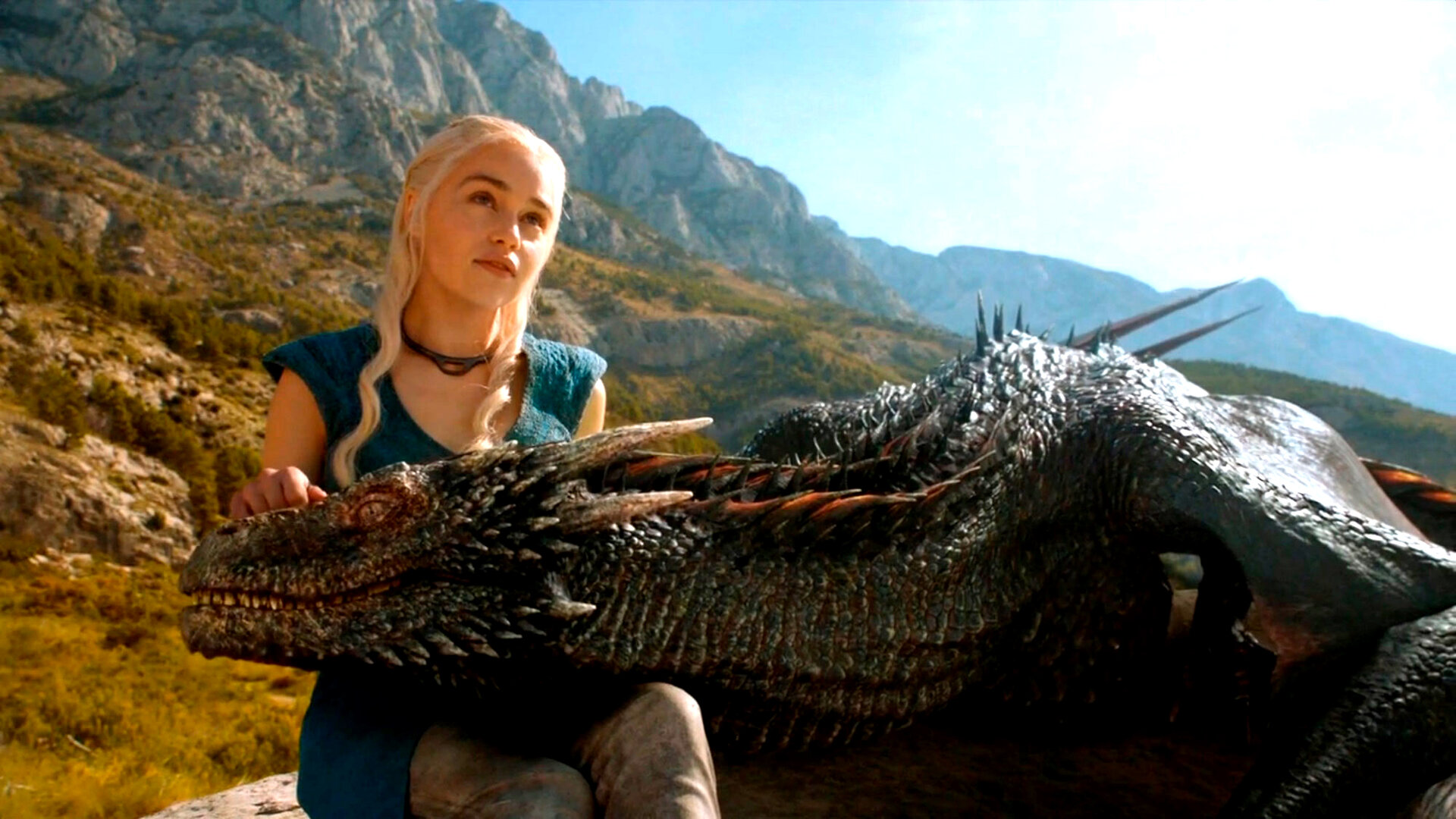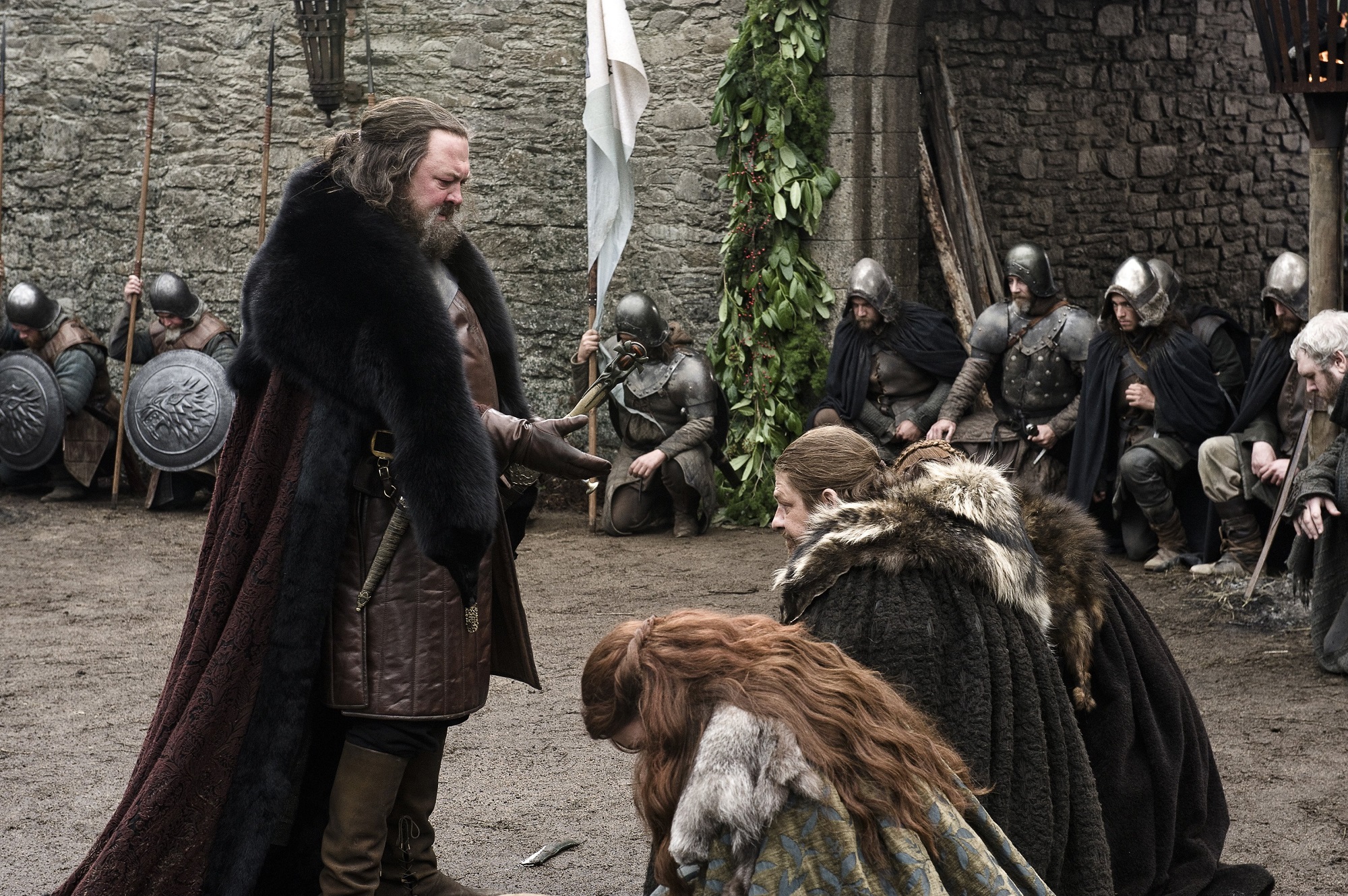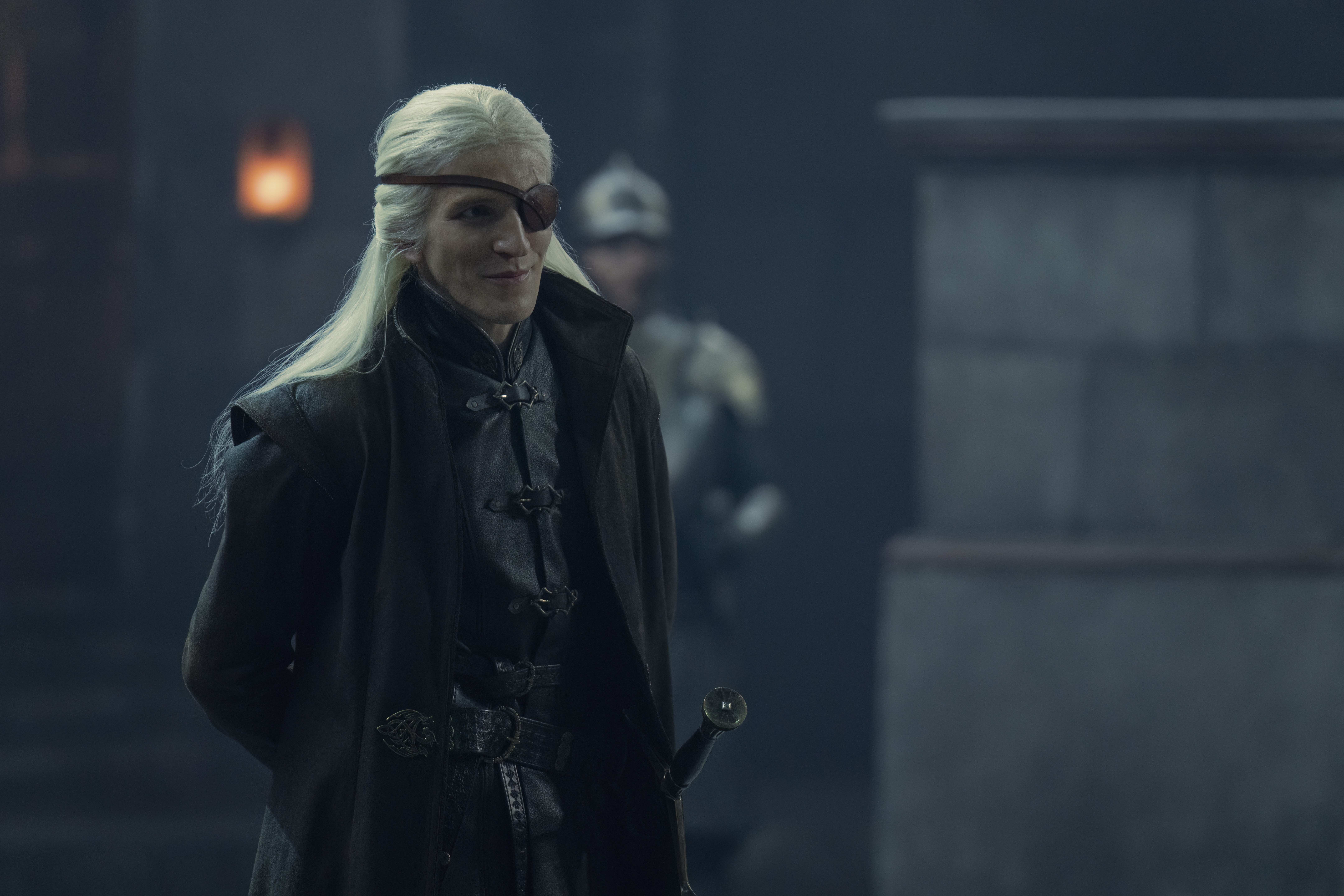
By Red Aly
Every mystery embedded in A Song of Ice and Fire offers rich ground for theories to germinate as we wait … and wait … for the conclusion of the series. The speculation is endlessly entertaining, sometimes profound, often frivolous. The best theories are community-building pursuits as they inspire animated discussion among fans and maintain interest between books and between seasons. This series of articles is intended in this spirit.
What will be offered here are not exhaustive theories, but seeds: Possibilities built from questions that may have very interesting answers in the books to come, and which are therefore a chance for us to test our own predictive powers. I will generally avoid topics that have been exhaustively investigated elsewhere unless I have something fresh and worthwhile to propose. The aim is to inspire speculative discussion. There is only one rule: Keep it fun!
Be warned though: The Look Into the Flames series will contain many spoilers and are intended for people who have read all of the A Song of Ice and Fire books released so far, as well as Fire and Blood.
“History does not remember blood. It remembers names.”
Corlys Velaryon in House of the Dragon
One of the objectives George R.R. Martin had in writing A Song of Ice and Fire was to subvert dominant tropes of the high fantasy genre. He has said that he was bothered by the idealization of medieval society in fantasy novels and so in response his own fantasy epic exposes in excruciating detail just how unjust and brutal medieval social structures really were, and also just how hard they were on women.
Westeros is patriarchal to the core. Because it is patriarchal, lands, swords, wealth and names are all passed down from fathers to sons. Wars are fought to prevent women from inheriting. We are given extensive family trees but they do not usually tell us much about what happened to the daughters. Often, they fail to mention the maiden names of the mothers. Whoever these women were before they married, Westerosi historians apparently consider them to entirely belong to their husbands’ families after marriage.
At the same time there are hints that the mothers do in fact matter. The most glaring hint of course is the Valyrian practice of marrying brothers to sisters to “keep the bloodlines pure”. This brother-sister marriage pattern is such a weird thing to give so much prominence if there is no reason for it except to unsettle the readers. Yes, the royal families of Europe were clearly inbred for centuries. It is possible that GRRM was simply trying to show us how sick real history actually was through exaggeration. This isn’t a history book though; it is a fictional epic rooted in inversion of fantasy tropes. Which is why for this article I would like to examine the possibility that GRRM is using A Song of Ice and Fire to flip our own lazy acceptance of the patriarchal premise on its head.

“Dragons are neither male nor female, Barth saw the truth of that, but now one and now the other, as changeable as flame.” – A Feast for Crows
This quote is a great starting point because it is one of the reasons why many people believe that Daenerys is The Prince that was Promised. It is a theory that seems to be further supported when we learn that the word for “prince” is a gender-neutral term in High Valyrian and that using the original language of the prophecy it could just as easily mean “princess”. Regardless of whether Daenerys turns out to be the subject of the prophecy, GRRM has certainly given us cause to examine female bloodlines in more depth and to see where they might lead. Where are the loose ends of the Targaryen family tree? Which other families, beyond those bearing the name Targaryen, should we be looking at more carefully for story clues now that we are paying more attention to the mothers and daughters?
In the case of the Blackfyres we have been directly told that we should follow the female line because the male line is extinct. This small moment in a conversation between Tyrion Lannister and Illyrio Mopatis is the basis for a great deal of well-researched fan speculation on the true objectives of Varys. It is interesting though how quickly fan theories pass right back to looking only at the men. Debates rage online on whether Young Griff is really a Targaryen or a Blackfyre or a Brightflame, completely ignoring the fact that generations have passed and in the meantime, new babies were born. For that, mothers were necessary. Why on earth are fans arguing about it instead of considering that Aegon is likely to be all of those things? Genes come from both parents and the Blackfyres were not the only offshoot of the Targaryen family who ended up in Essos. What about Saera, daughter of Jaehaerys? Interesting isn’t it how close her name is to Serra, wife of Illyrio? Best to think of Essos as a melting pot bringing these threads together. That is easier to do if fans remember that babies are not just made by fathers, no matter what historians making family trees might say. In truth it is NOT about the name, but about the blood.
With this in mind let’s consider briefly a moment early in the series where Ned Stark is asked why he did not just take the Iron Throne for himself when he had the chance. His answer is that Robert Baratheon had the better claim. He was referring of course to the fact that Robert Baratheon’s grandmother was Rhaelle Targaryen. This, along with earlier Targaryen links during the conquest, meant that the Baratheon family was an offshoot of the Targaryen family, and this fact gave them more legitimacy than conquest alone. But I am not the first to wonder why Ned said “the better claim” instead of “I had NO claim.” If they were searching for a touch of legitimacy after the rebellion via links to the defeated dynasty, then surely saying “I had no claim” would have been more accurate? Maybe he too has a female line Targaryen hidden somewhere in his family tree.
I can already see some people’s eyes rolling. Not another hidden Targaryen!
Indeed, the number of characters fans have proposed might be hidden Targaryens over the years and the level of ridiculousness of some of these theories is reason to proceed with extreme caution. I think that our objectives in this are important though. I am not looking for hidden Targaryens because I want to support some outrageous new theory for who the third head of the dragon might be. Rather the opposite: I would be more interested in tracing the female line back to the characters who we know to have Targaryen lineage. For example, I am curious why, after centuries of marrying brothers to sisters to keep the bloodlines pure, it seems not to have mattered in the end that Daenerys Targaryen, indisputably a “dragon,” appears to be half Blackwood by blood (as indeed was her brother Rhaegar). The series has many unresolved storylines and knowing more about mothers and daughters and where they ended up might prove very enlightening. When it comes to the women, there are so many loose ends.
So many in fact that to me it feels deliberate. It feels like GRRM left those strings hanging until he could be certain of the details, and at the same time he is using extreme patriarchy of historical records to hide things that are actually significant. Fans looking only at family names and not full bloodlines make that so easy.
Diving into history then, the first loose end left hanging is an unnamed second daughter of Daenys the Dreamer who would have been born 80 or more years before the conquest. We know that she married, and we know she had at least one child. We do not know how many or who they were. It is probably safe to assume though that this daughter’s bloodline fed into another Valyrian family such as the Velaryons, and that from there it probably fed right back into the main Targaryen family. Chances are high in other words that Aerys, grandson of Daenys, married his cousin who was a granddaughter of Daenys, bringing together male and female lines. House Velaryon meanwhile did not marry only Targaryens and other Velaryons. The same is true for any other Valyrian families this daughter may have married into. These families could have passed on their drop of dragon blood from Daenys to other families in Essos and Eastern Westeros, and this in turn may have been a factor in alliances and marriages in the following generations.
Moving forward in time, I have already mentioned Saera daughter of Jaehaerys I and Alysanne. She is known to have been mother to at least 3 bastards who were born in Lys and Volantis after 80 A.C. Some of her bastards presented their claims for the Iron Throne during the Great Council of 101, and so it is clear they had ambitions in Westeros. This was not long before the conflicts began with the Triarchy, a fact which may be relevant, given those ambitions, since Lys was part of the Triarchy. It is worth also wondering if any of Saera’s children had a connection to House Rogare of Lys who we know had the Valyrian look and owned a pillow house such as the one where Saera established herself. If so, Saera’s line may have fed back into House Targaryen via Larra Rogare, mother of Aegon IV and his sister-wife Naerys. By other routes I would consider it likely that it eventually merged with the Blackfyre line.

Next, we need to look at the Dance of the Dragons. We know that Aemond Targaryen’s lover (possibly wife) Alys Rivers of Harrenhal was pregnant with his child late in the war. A short time later she led a rebellion in her child’s name. Her story goes cold because historians did not track her after the winter fever of 133, but this child, if he lived, would have been the only survivor of the Greens’ bloodline and would have been protected by the supporters of the Greens in the Riverlands such as House Bracken or House Vance of Atranta. Beyond that there is a small possibility that this child carried the otherwise extinct bloodlines of either Visenya or Rhaena (wife of Aegon the Uncrowned) for reasons I will clarify in a future article parsing Harrenhal’s history and that of the relevant Riverlands and Crownlands Houses.
Following the Dance we know of multiple descendants of Rhaena and Baela Targaryen born between 136 and 165 A.C. This is the female line of Rhaenys, Queen who Never Was. Baela and husband Alyn Velaryon had at least one child and probably more as we know Baela was pregnant a second time. Rhaena had six Hightower daughters. We know next to nothing at all about any of them except that they existed. I suspect though that the sequence of events during and after the war offers some clues, for example we know that Alyn Velaryon and Benjicot Blackwood became friends during the Vale’s succession conflict. A decent chance exists that a daughter of Alyn and Baela’s became a Blackwood. Rhaena’s connections in the Vale during the Dance likely mean that at least one of her six daughters married into a Vale family (Corbray, Aryn, Royce). Others would have stayed in or closer to Oldtown (Hightower cousins, Tyrell, Redwyne, Rowan, maybe even Dayne). So, while there are no family trees that clarify the issue, there are hints dropped here and there in the histories regarding which families might be worth looking at when more details are available.
Moving ahead a generation, Aegon IV of course was promiscuous and spread his seed far and wide. Daena Targaryen and Aegon IV were the source of the male Blackfyre line. But Daemon Blackfyre and his right hand Aegor Rivers were not Aegon IV’s only legitimized bastards. Bloodraven had no children that we know of but he did have two full sisters Mya and Gwenys. As great bastards of the King they would have married well to Blackwood cousins of the main line or to Blackwood allies. If they had children they were born between 186 and 224 A.C.
Then there is Elaena, daughter of Aegon III, sister of Daena. She had two bastards with Alyn Velaryon, one son born nominally a Plumm, and four Penrose children born between 184 and 195 A.C. . We can’t trace any of them. We only know that House Penrose fought against the Blackfyres in their rebellions, so Elaena’s Penrose descendants probably remained in families that were loyal to the crown during that time. Her Plumm grand- or great-grandaughters if they existed likely married into other Westerlands Houses such as Marbrand, Westerling, or Reyne; perhaps the roots of Ellyn Reyne’s arrogance and ambition lay in her proud lineage.
Yet another tantalizing loose end concerns Jenny of Oldstones. There is so far no indication that she and Duncan had any children, or if they did, that they did not die at Summerhall along with their father and much of the Targaryen family. Their line most likely ended. I do wonder why though, if Duncan’s line is extinct, are there repeated references in the books to the Prince of Dragonflies in both Sansa and Catelyn’s chapters. Whether Sansa is a descendant of Duncan and Jenny or not via Catelyn Tully, clearly we are supposed to associate her with them. Meanwhile Petyr Baelish does not come across as a hopeless romantic but more of a sociopath. Since regardless of what he says, love seems unlikely to actually be his motive for going after first Catelyn and then Sansa, it is worth wondering what about their bloodline is.
Finally, we have Aegon V’s two sisters Daella and Rhae. Both are known to have birthed unknown numbers of children into unknown families. Their mother was a Dayne which may have influenced where they ended up, though we will have to wait for the next instalment of Fire and Blood to know more. But I can’t be the only reader to look at these vague loose ends and wonder why. Surely these sisters and daughters and offspring would not have been mentioned at all if there was no plan for them? What does all of this mean?
Well, if the Blackfyre line likely merges together the bloodlines of various exiles and bastards, it is reasonable to consider that something similar has been happening in Westeros. This is not a linear story of father to son, but instead it is a more subtle splitting and merging pattern involving both sides of characters’ lineages. If we start with Jaehaerys, essentially 3 bloodlines survived from him; that of Rhaenys, daughter of Aemon, that of Rhaenyra who descended from all of Daella, Alyssa and Baelon, and that of Saera and her Essos bastards. Before and since then there have been more splits and more merges but it all moves in a steady flow that does not ignore one half of the genes just because historians do. It leads to our eventual three heads of the Dragon. Possibly these bloodlines may even be seeking each other out and this is why Targaryen brothers and sisters often became so intensely attracted.
It could be why Aegon IV chose several of the mistresses he did and maybe the rivalry between Bloodraven and Bittersteel for Shiera Seastar’s affections is hinting at some deeper driving force. Or maybe tracing the female line just explains the various wars of Westeros in a new light by providing a clear basis for significant alliances and rivalries.
Whatever it is, hints and open questions on the female line that George R.R. Martin has provided give us a great deal to think about.
The post Look Into the Flames: The Female Line of House Targaryen appeared first on Watchers on the Wall.
Via http://watchersonthewall.com
No comments:
Post a Comment